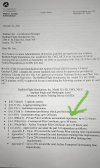Ok. I've read all the regs. Let me get this right.
So the simulated instrument during private phase doesn't count for instrument time for instrument rating.
The Sim time during private doesn't count for instrument rating.
Does it count for commercial rating then? It's not very specific in the reg which says 50 hours it just says "Credit a maximum of 50 hours toward the total aeronautical experience requirements for an airplane or powered-lift rating, provided the aeronautical experience was obtained from an authorized instructor in a full flight simulator or flight training device that represents that class of airplane or powered-lift category and type, if applicable, appropriate to the rating sought;"
It doesn't say thr sim time has to be specifically for commercial training.
So will the 20 hours sim time max for instrument count towards the 50 for commercial? What about any sim time done for private?
I'm befuddled here because if I waste 20 or 50 hours on a sim only to realize I havw to pay again for flight time, then I may as well log flight time.
The only way to know is if a current CFI or commercial pilot who used 50 hours sim time or close to it can clarify.
Before anyone asks yes our sim has an LOA and is legit. Others have used it and been able to meet the aeronautical requirements.
The wording is just so confusing.
If the 20 hours sim time for instrument counts for the 50 total in commercial than I'll do some sim time too, and still mostly do 80% flight 20% sim.
If instrument sim time doesn't count for commercial than it's a waste of time and I'll get flight hours instead.
Does private sim time count for commercial?
The commercial minimum training time is only 20 hours and instrument is 40 hours of which only 15 are required to have an instructor.
Does the safety pilot need to be an instrument pilot during instrument training or can it be a private pilot and we fly in VMC conditions while I put on the hood?
I have 125 hours. If I get 20 hours sim time and 20 hours training that's $2600 for 20 hours sim time and $4360 for 20 hours actual instrument flying.
Then I'd have 145 flight hours and 20 sim. By the time I complete my 50 xc hour requirements for IR rating I'll have about 175 hours and by the time I get 100 hours PIC I'll have 217 hours with 20 hours sim TIME. Add in 20 hours commercial training that's 237hrs with 20 hours sim time it would be 237 flight + 20 sim equals =257. Would this be enough to get a commercial pilot license?
So the simulated instrument during private phase doesn't count for instrument time for instrument rating.
The Sim time during private doesn't count for instrument rating.
Does it count for commercial rating then? It's not very specific in the reg which says 50 hours it just says "Credit a maximum of 50 hours toward the total aeronautical experience requirements for an airplane or powered-lift rating, provided the aeronautical experience was obtained from an authorized instructor in a full flight simulator or flight training device that represents that class of airplane or powered-lift category and type, if applicable, appropriate to the rating sought;"
It doesn't say thr sim time has to be specifically for commercial training.
So will the 20 hours sim time max for instrument count towards the 50 for commercial? What about any sim time done for private?
I'm befuddled here because if I waste 20 or 50 hours on a sim only to realize I havw to pay again for flight time, then I may as well log flight time.
The only way to know is if a current CFI or commercial pilot who used 50 hours sim time or close to it can clarify.
Before anyone asks yes our sim has an LOA and is legit. Others have used it and been able to meet the aeronautical requirements.
The wording is just so confusing.
If the 20 hours sim time for instrument counts for the 50 total in commercial than I'll do some sim time too, and still mostly do 80% flight 20% sim.
If instrument sim time doesn't count for commercial than it's a waste of time and I'll get flight hours instead.
Does private sim time count for commercial?
The commercial minimum training time is only 20 hours and instrument is 40 hours of which only 15 are required to have an instructor.
Does the safety pilot need to be an instrument pilot during instrument training or can it be a private pilot and we fly in VMC conditions while I put on the hood?
I have 125 hours. If I get 20 hours sim time and 20 hours training that's $2600 for 20 hours sim time and $4360 for 20 hours actual instrument flying.
Then I'd have 145 flight hours and 20 sim. By the time I complete my 50 xc hour requirements for IR rating I'll have about 175 hours and by the time I get 100 hours PIC I'll have 217 hours with 20 hours sim TIME. Add in 20 hours commercial training that's 237hrs with 20 hours sim time it would be 237 flight + 20 sim equals =257. Would this be enough to get a commercial pilot license?

